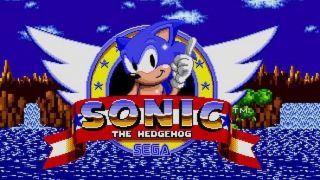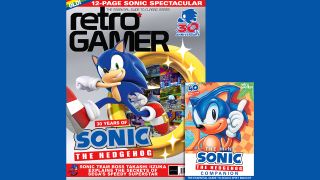Sonic the Hedgehog turns 30: How Sega transformed 'Mr Needlemouse' into one of gaming's most enduring icons
Former head of Sonic Team Yuji Naka reflects on the making of Sonic the Hedgehog

Sega's iconic blue mascot just turned 30-years old. He's starred in some of the best Mega Drive games and appeared in over 80 video games in that time – everything from platformers, racing games, fighting games, and more. To celebrate the 30th anniversary of Sonic the Hedgehog, Retro Gamer speaks to Sonic creator, Yuji Naka, about the origins of the original Mega Drive classic.
Before Sonic spun onto the scene in a dazzling blur of cobalt blue, Sega's previous attempts to create a company mascot had been unsuccessful. Their primary intent was to capture hearts in the same way that Mario had done for Nintendo, but nothing seemed to fit. Fantasy Zone's ovoid spaceship Opa-Opa is often referred to as the very first mascot, briefly holding on to the honour until a tracksuit-wearing, rock-smashing prince named Alex Kidd came along and took his paper crown.
But when creating Alex, it's debatable that Sega had hit upon the key ingredients that would give them a character to match the might of Mario. Younger and more athletic than Nintendo's tubby talisman, trained in a martial art and able to drive an assortment of vehicles, Alex Exhibited many of the same characteristics that Sega would imbue into Alex's spiny successor. For connecting with a young audience, Alex certainly had a lot going for him. Unfortunately, he had a tough time competing against Nintendo's all-conquering NES, which at one time could be found in 1 in 4 American households.
Two years after the 1989 release of the Genesis in North America, Sega found itself in a fairly strong position stateside. Its arcade machines Space Harrier, OutRun and Shinobi were proving popular coin guzzlers, and its powerful new 16-bit successor to the Master System was also selling well thanks to its impressive visuals and early library of arcade tie-ins. But conscious that Nintendo was preparing to release its 16-bit successor to the NES any day now, Sega knew it needed to find itself a Mario, and fast. So it was that Sega of Japan famously set its best designers the task of coming up with a brand new hero to represent the company and its new console.
Blurring the lines


If you want in-depth features on classic video games delivered straight to your doorstop, subscribe to Retro Gamer today. For more on Sonic's 30th anniversary, buy Retro Gamer issue 221 for a Sonic spectacular.
During the initial ideas stage many designs were pitched and considered; rabbits, armadillos, even human characters, but in the end it was a teal-coloured hedgehog that was finally selected, put forward by artist Naoto Oshima, who had previously worked as a designer on the first two Phantasy Star games. Originally dubbed Mr Needlemouse, Oshima's creation went through a number of changes before becoming the zippy blue hedgehog we know today. Early concepts for the character, which were dropped as a result of a makeover by Sega of America, had him playing in a rock band, his mouth drawn with fangs, and in a relationship with a blonde human girl named Madonna.
For obvious reasons Sonic's colour was altered to Sega blue, while Oshima has revealed that Sonic's iconic red power sneakers were inspired by a combination of the belt-strapped boots Michael Jackson's wore on the cover of his album Bad and the colour of Santa Claus, whom Oshima regarded at the time as the most 'famous character in the world.' Blending all these visual elements together, Sega hoped it had the perfect character to appeal to an American market. All Oshima needed now was a striking game to show his creation off, and it was here that Sega bosses turned to a talented programmer named Yuji Naka. Naka had become renowned in the company for his impressive programming skills thanks to his work on Phantasy Star.
He had also proven his skill for tackling the platform genre, with an impressive Mega Drive conversion of Ghouls 'n' Ghosts. And so Sega asked Naka and Hirokazu Yasuhara, Sonic's game planner/level designer, to help Oshima bring Sonic to life and become the driving force in a team of AM8 developers. They were later famously renamed Sonic Team. When work on the project began, Naka was adamant the game should be fast and exhilarating to show off the impressive processing speed of the Mega Drive.
Sign up to the 12DOVE Newsletter
Weekly digests, tales from the communities you love, and more

An important cornerstone for the game, Yuji Naka explains how it was Super Mario Bros. that inspired him to create the fastest platformer the world had ever seen. "Every time I played the first stage I wondered why I couldn't clear it faster, the better I got playing it," Naka explains.
"This feeling must have been the beginning of the idea of Sonic, as you get good at playing you can run through the stage really fast. I think Sonic itself turned out to be a totally different concept to Super Mario Bros. But I do feel it was a game that affected me very positively. There is a part in Sonic 1 where Sonic swims in the water and eats bubbles to take his breath to go on. I was very happy when Super Mario Bros. later used a similar system in one of its sequels, because I felt we were inspiring each other."
Meanwhile, Yasahura's approach to Sonic's level design was to create them in such a way that they would appeal to both casual and hardcore gamers. He set about achieving this by mixing fun level elements with challenging obstacles and moving parts. Of the seven zones in the game, Sonic's opening stage Green Hill Zone became the most iconic. A vibrant place featuring blue skies, lush green grass, chequerboard tunnels and loop the loops; the perfect playground for Sonic to showcase all his abilities. It was a brilliantly attention-grabbing introduction for gamers, and for those who had never owned a console. So where did inspiration for this iconic stage come from?
"Green Hill Zone was inspired by California," Naka answers simply. "Also we were aiming to show the latest computer graphics at that time, which were using polygon and ray tracing, through pixel art to make it look very new. With regards to the colours, I believe they were inspired by a picture drawn by Eizin Suzuki."

Eizin Suzuki's work frequently features stunning pop city illustrations that look every bit the kind of artwork we'd have expected to see up on the walls inside Sega at that time. Often depicting bright realism with a vivid surreal edge, one piece in particular instantly catches our attention. It shows a classic red open-top sports car parked beside a welcoming beach-side restaurant. With its deep blue skies and engagingly expressive colours, the connection is clear. From a technical perspective, Naka says that the biggest challenge in getting the Mega Drive to accommodate Sonic came from the processing speed of its hardware.
And with Sonic pushing the Mega Drive in a way that no game had done before, there were several features that Naka and his team wanted to incorporate into the game, but with space and time constraints were unable to. Interestingly, one of these omitted features would later provide the starting point for the sequel, while another inadvertently gave rise to a popular Sega motif.
"There were two features that we were not able to put into Sonic 1," Naka explains. "The first one was to support two players playing at the same time. At the last point of developing Sonic we were doing tests with splitscreen in order to allow two players to play at the same time. But my technical capability wasn't enough to allow the game to be completed with this feature. When we began work on Sonic 2 we tested this first to ensure that a two-player game system was achieved before properly starting the project."

"We also tried to prepare a sound select screen, with pictures of Sonic's band, and Sonic singing and break-dancing. The pictures were mostly completed but we couldn't make this feature fully completed on schedule, so it was rejected. But the storage on the ROM to put this feature in was available because of this, so we added the 'Sega' voice on the part where we showed the Sega logo. In the end, I think this was a good idea."
From the initial concept for Sonic that saw him playing in a rock band to the revelation of a sound select screen that had to be dropped, it's clear that Naka and his team always intended for music to play an important part of the game. We were therefore keen to find out how much planning went into that particular aspect, and how the team ensured it would enhance the overall experience for players as successfully as it did.
"It was just around the time when music in games was first getting exciting, so we asked Masato Nakamura, a member of Dreams Come True [a famous pop band in Japan] to make the music for each stage sound like it was based on each stage's image. Sonic also put a lot of pressure on us not only in regards to the music but the sound FX and jingles. We fixed these quite a lot to allow them to make players feel good while they play the game."
Final sprint

"Sonic put a lot of pressure on us not only in regards to the music but the sound FX and jingles."
Yuji Naka
Initially Sega of America had doubts about Sonic's American appeal, concerned that Americans wouldn't know what a hedgehog was. However, following a few tweaks by SOA to soften up the character for Western gamers, a change that at fi rst didn't go down too well with the members of Sonic Team, Sonic the Hedgehog was finally finished and released in 1991.
Looking more coin-op than console game, Sonic the Hedgehog helped to bridge the gap between those two markets more successfully than any Mega Drive title previously released, and became an instant classic as a result. And when Nintendo finally released the Super NES in North America later that year, it led to one of the biggest and most memorable console wars in gaming history. Following an aggressive marketing campaign by SOA, Sonic quickly became synonymous with Sega.
And when Sega of Japan gave into its initial reluctance to offer the game as a pack in with Genesis consoles, Sonic went on to play an even bigger role in helping Sega take majority share of the North American games market away from NintendoSonic's contribution to Sega's success certainly cannot be underplayed. But looking back on this most important of Sega success stories, which aspect of Sonic the Hedgehog is Naka most proud of?
"I think the fact the game is designed to be very fast but can also be controlled, and allow you to zip through the game nicely, is the part which I am most proud of. Thanks to Sonic Team members for putting great effort into this part. I am also proud of Sonic being played by so many people around the world. Thank you so much."
This feature first appeared in issue 100 of Retro Gamer magazine. For more excellent features, like the one you've just read, don't forget to subscribe to the print or digital edition at MyFavouriteMagazines.
Retro Gamer is the world's biggest - and longest-running - magazine dedicated to classic games, from ZX Spectrum, to NES and PlayStation. Relaunched in 2005, Retro Gamer has become respected within the industry as the authoritative word on classic gaming, thanks to its passionate and knowledgeable writers, with in-depth interviews of numerous acclaimed veterans, including Shigeru Miyamoto, Yu Suzuki, Peter Molyneux and Trip Hawkins.












